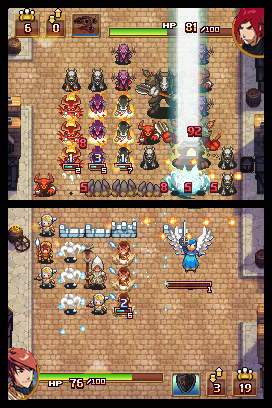Overview
Might & Magic: Clash of Heroes is a puzzle RPG developed by Capybara Games and published by Ubisoft. It was announced on May 13th, 2009 and was released on November 17th, 2009 -- having been pushed back from its original August 25th and later October 13th release date. It was also released on the Playstation Network on April 12, 2011, the Xbox Live Marketplace on April 13, 2011, and the Apple App Store on January 24, 2013.
The game is a prequel to the 2006 strategy/RPG Heroes of Might and Magic V, and the 2006 FPS/Action RPG Dark Messiah of Might and Magic. It is set about 40 years before the events of Heroes V (which brings it to around 946 YSD in the timeline), with some characters making appearances throughout the games. Most notably Anwen and Godric who are also playable characters in Heroes V.
Gameplay
 Battles are turn-based head to head.
Battles are turn-based head to head.In Might and Magic: Clash of Heroes, the two screens are set up as opposing sides on a battlefield, with the players units on the bottom screen and the enemy units on the top screen.
The game is turn-based, with the first turn of the game getting two moves and every other getting three. The goal of the player is to send its characters to the top of the top screen to damage the opposing player while building walls to protect the bottom of the lower screen.
Each screen is home to an invisible 8 by 6 grid. The typical units take up one grid space, while others take either two or four units. To activate attacks, players must take units from the bottom of one column and move them to the bottom of another column, creating lines of three units of the same color. Moving a unit takes one move. Once those units are connected, they move to the top of the bottom screen and begin to glow, and a number appears over the units in question. That number tells the player how many turns it will be before those units attack. Attack power can be increased by linking: creating attack combinations of a single color that attack on the same turn, or by fusion: creating a duplicate of an attacking formation behind an existing one.
 Be careful of four-panel units
Be careful of four-panel unitsTo defend against attacks from the opposing side, the player can make rows of 3 or more. Doing so makes the units used vanish, and a wall takes their place. Those units that are removed from the field can all be brought back at any time at the cost of a move.
Alternatively, players can also remove units from the battlefield, allowing other units in the column to connect. Removing units also takes a move, but if removing a unit directly results in either a wall or attack, the player gets a move back for each wall and attack that results.
Typical units will return no matter how many times they are killed or used. The same cannot be said about Elites and Champions, which take up two and four spaces on the grid respectively. Elites only need two basic units of the same color behind them, while Champions need four units of the same color to be activated. Only two of these special types of units can be equipped for a battle, and if they are killed or thwarted in battle, they have to be purchased at in-game stores to be used again, although not in multiplayer. These two and four square units all have special abilities like being able to jump over walls or absorb the power of idle units on their way to the top of the upper screen.
 Wall-building can be the key to victory
Wall-building can be the key to victoryThe commander and artifacts act like modifiers to battle. Commanders have a spell that is charged by either taking or dealing damage. Artifacts possess a range of effects, including unit attributes, attack power, special effects, and starting conditions. You can only equip one artifact at a time. The multiplayer starts with 5 commanders (one for each faction), and playing through each faction's campaign nets you another commander. Many artifacts can also be unlocked by playing the campaign.
The campaign also adds quirks to battles by changing win conditions on specific battles. Some may have the player try to hit a specific target to advance, while others ask the player to coordinate attacks. Also included in the campaign are puzzle battles, where there is only a single turn to make enough attacking combinations with the preset units to kill all the preset defenders.
Story
 The Story is told through still artwork and scrolling text
The Story is told through still artwork and scrolling textThe game begins with a meet-up between leaders of three different kingdoms and their children. You start the game as Anwen, an elvish girl who has been groomed to be the leader of her people. After receiving guests at a nearby portal, she returns to a campsite where she discovers her friends and family have been attacked by demons. She and four others manage to return to the portal, where they are separated and spread to the five different regions of the world. The rest of the player's time revolves around uncovering the demon plot and putting a stop to the evil masterminds behind it. While the plot isn't especially inventive or special, it is told in an enjoyable manner.
PSN & XBLA
![XBL]() XBL "Boxart"
XBL "Boxart"On April 11 and 12, 2011, Ubisoft released an HD version of the game on the Playstation Network for $US15.00/£9.99 and on the Xbox Live Marketplace for 1200 Microsoft Points.
PC Version
On September 22nd, 2011, Might & Magic: Clash of Heroes is going to be made available on the PC through digital distribution.
Pre-order on Steam includes the "I Am the Boss" DLC for free.
Music
The music in this game include remixes of themes from past Heroes of Might and Magic games. Most notably Heroes V, since the games share setting and story.
PC System Requirements
| Minimum | Recommended |
|---|
- OS: Windows® 2000 / Windows® XP / Windows Vista® / Windows® 7
- Processor: 1.5 GHz Dual Core or 2.8 GHz Single Core
- Memory: 1 GB Windows 2000 – Windows XP / 1 GB Windows Vista – Windows 7
- Graphics: 256 MB DirectX® 9.0-compliant card with Shader Model 3.0 or higher (*see supported list)
- DirectX®: DirectX 9.0c or higher
- Hard Drive: 1.6 GB
- Sound: DirectX 9.0-compliant sound card
- *Supported Video Cards at Time of Release:ATI Radeon™ HD 2000/ HD 3000/ HD 4000/ HD 5000/ HD 6000 series
NVIDIA® GeForce® 7600GS / 8 / 9 / 100 / 200 / 300 / 400 / 500 series
| - OS: Windows 7
- Processor: 2.0 GHz Intel® Core™2 Duo or AMD Athlon™ 64 X2 6000+ or better
- Memory: 2 GB
- Graphics: 512 MB DirectX 9.0-compliant card with Shader Model 3.0 or higher (*see supported list)
- DirectX®: DirectX 9.0c or higher
- Hard Drive: 1.6 GB
- Sound: DirectX 9.0-compliant sound card
- *Supported Video Cards at Time of Release:ATI Radeon™ X1300 / HD 2000/ HD 3000/ HD 4000/ HD 5000/ HD 6000 series
NVIDIA® GeForce® 7600GS / 8 / 9 / 100 / 200 / 300 / 400 / 500 series
|
Log in to comment